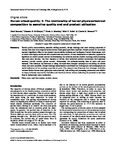Durum wheat quality: II. The relationship of kernel physicochemical composition to semolina quality and end product utilisation
| dc.contributor.author | Samaan, J | |
| dc.contributor.author | El-Khayat, GH | |
| dc.contributor.author | Manthey, FA | |
| dc.contributor.author | Fuller, Michael | |
| dc.contributor.author | Brennan, CS | |
| dc.date.accessioned | 2013-03-03T17:35:11Z | |
| dc.date.available | 2013-03-03T17:35:11Z | |
| dc.date.issued | 2006-01-01 | |
| dc.identifier.issn | 0950-5423 | |
| dc.identifier.issn | 1365-2621 | |
| dc.identifier.uri | http://hdl.handle.net/10026.1/1438 | |
| dc.description.abstract |
<jats:title>Summary</jats:title><jats:p>Kernel quality characteristics, semolina milling potential, dough rheology and pasta making properties of kernels from nine fully irrigated Syrian durum wheat genotypes were observed. Protein content of the kernels exerted a significant affect on the physical characteristics hardness and the degree of kernel vitreousness, both of which were highly correlated with superior end‐use product. Gluten composition of semolina appeared as significant as overall protein content in determining the optimum end‐use product cooking quality (cooking time and pasta texture). The final viscosity of durum flour exhibited positive correlations with semolina recovery, protein content, gluten content, vitreousness, the optimum‐cooking time of pasta and pasta firmness. This indicates the relevance of using the rapid visco analyser technique in evaluating the durum wheat and pasta qualities. Dough rheology measurements confirmed that farinograph and extensograph are useful indicators of the cooking properties of pasta. The research also illustrates that although variability between Syrian durum wheat genotypes were observed, their milling and processing parameters were similar to those previously reported for Canadian and American durum wheats, indicating the potential to use these lines in mainstream pasta production.</jats:p> | |
| dc.format.extent | 47-55 | |
| dc.format.medium | Undetermined | |
| dc.language | en | |
| dc.language.iso | en | |
| dc.publisher | Wiley | |
| dc.subject | gluten | |
| dc.subject | pasta | |
| dc.subject | rapid visco analyser | |
| dc.subject | semolina | |
| dc.subject | vitreous | |
| dc.title | Durum wheat quality: II. The relationship of kernel physicochemical composition to semolina quality and end product utilisation | |
| dc.type | journal-article | |
| dc.type | Journal Article | |
| plymouth.author-url | https://www.webofscience.com/api/gateway?GWVersion=2&SrcApp=PARTNER_APP&SrcAuth=LinksAMR&KeyUT=WOS:000243005900007&DestLinkType=FullRecord&DestApp=ALL_WOS&UsrCustomerID=11bb513d99f797142bcfeffcc58ea008 | |
| plymouth.issue | s2 | |
| plymouth.volume | 41 | |
| plymouth.publication-status | Published | |
| plymouth.journal | International Journal of Food Science and Technology | |
| dc.identifier.doi | 10.1111/j.1365-2621.2006.01313.x | |
| plymouth.organisational-group | /Plymouth | |
| plymouth.organisational-group | /Plymouth/Faculty of Science and Engineering | |
| plymouth.organisational-group | /Plymouth/Faculty of Science and Engineering/School of Biological and Marine Sciences | |
| plymouth.organisational-group | /Plymouth/REF 2021 Researchers by UoA | |
| plymouth.organisational-group | /Plymouth/REF 2021 Researchers by UoA/UoA06 Agriculture, Veterinary and Food Science | |
| plymouth.organisational-group | /Plymouth/Users by role | |
| plymouth.organisational-group | /Plymouth/Users by role/Academics | |
| dc.identifier.eissn | 1365-2621 | |
| dc.rights.embargoperiod | Not known | |
| rioxxterms.versionofrecord | 10.1111/j.1365-2621.2006.01313.x | |
| rioxxterms.licenseref.uri | http://www.rioxx.net/licenses/all-rights-reserved | |
| rioxxterms.type | Journal Article/Review |


